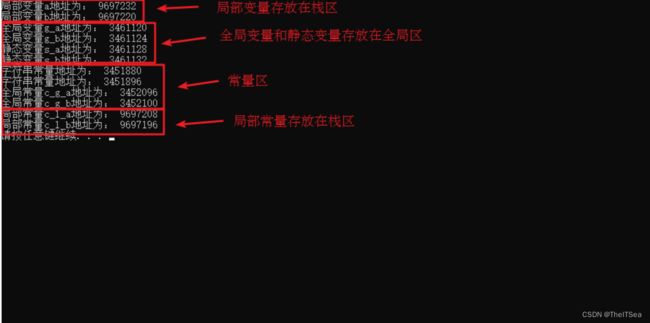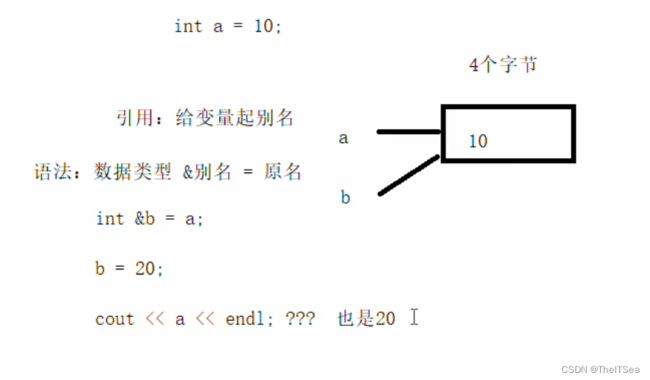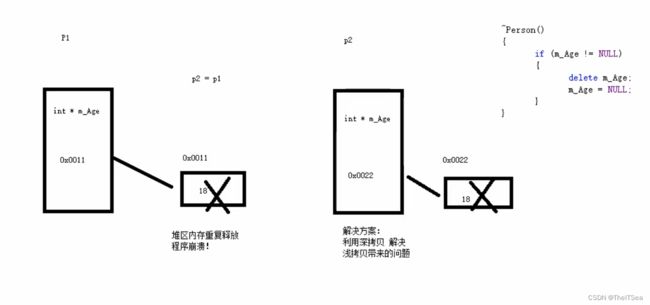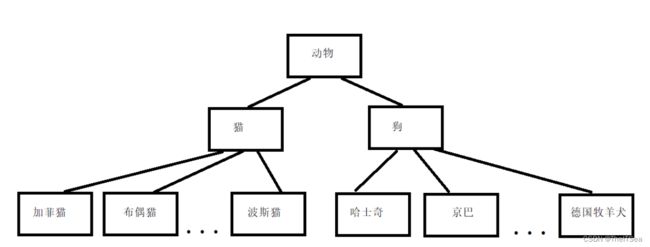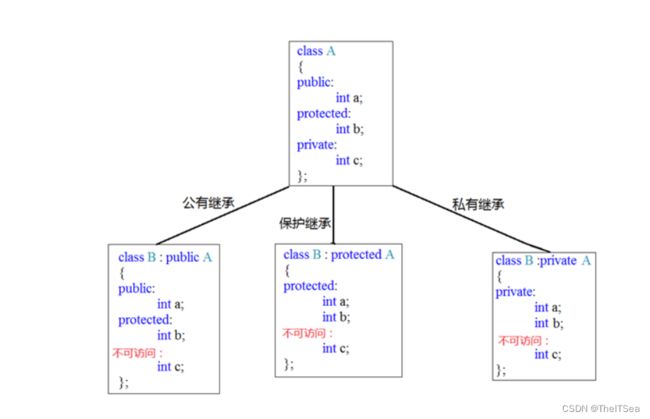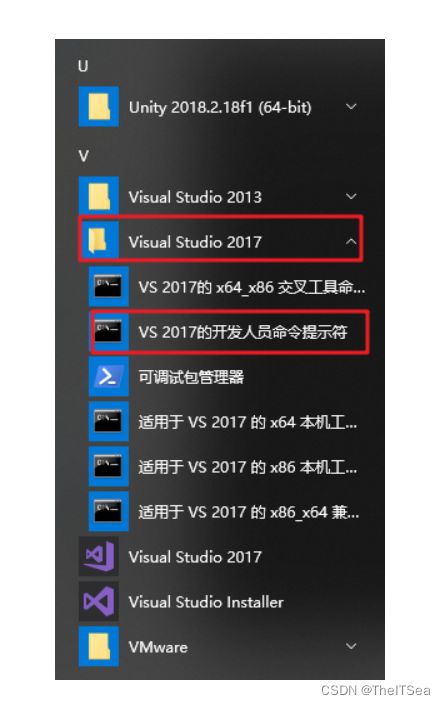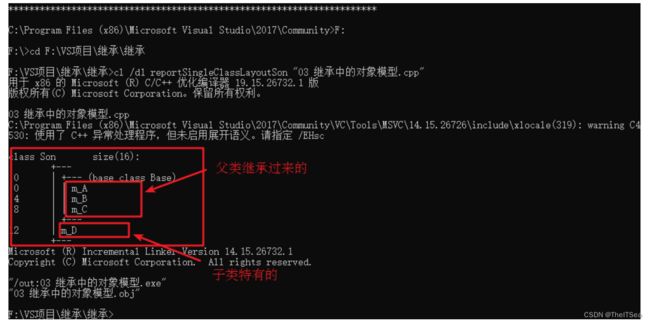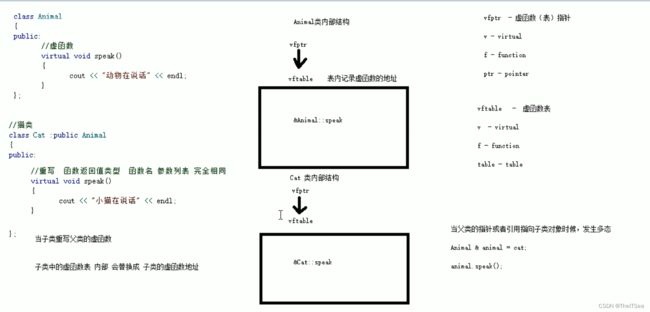C++中级:核心编程
C++核心编程
本阶段主要针对C++面向对象编程技术做详细讲解,探讨C++中的核心和精髓。
1 内存分区模型
C++程序在执行时,将内存大方向划分为4个区域
- 代码区:存放函数体的二进制代码,由操作系统进行管理的
- 全局区:存放全局变量和静态变量以及常量
- 栈区:由编译器自动分配释放, 存放函数的参数值,局部变量等
- 堆区:由程序员分配和释放,若程序员不释放,程序结束时由操作系统回收
内存四区意义:
不同区域存放的数据,赋予不同的生命周期, 给我们更大的灵活编程
1.1 程序运行前
在程序编译后,生成了exe可执行程序,未执行该程序前分为两个区域
代码区:
存放 CPU 执行的机器指令
代码区是共享的,共享的目的是对于频繁被执行的程序,只需要在内存中有一份代码即可
代码区是只读的,使其只读的原因是防止程序意外地修改了它的指令
全局区:
全局变量和静态变量存放在此.
全局区还包含了常量区, 字符串常量和其他常量也存放在此.
该区域的数据在程序结束后由操作系统释放.
示例:
//全局变量
int g_a = 10;
int g_b = 10;
//const修饰的全局变量
const int c_g_a = 10;
const int c_g_b = 10;
int main() {
//局部变量
int a = 10;
int b = 10;
//打印地址
cout << "局部变量a地址为: " << (int)&a << endl;
cout << "局部变量b地址为: " << (int)&b << endl;
cout << "全局变量g_a地址为: " << (int)&g_a << endl;
cout << "全局变量g_b地址为: " << (int)&g_b << endl;
//静态变量 在普通变量前面加上static就是静态变量
static int s_a = 10;
static int s_b = 10;
cout << "静态变量s_a地址为: " << (int)&s_a << endl;
cout << "静态变量s_b地址为: " << (int)&s_b << endl;
//常量
//字符串常量
cout << "字符串常量地址为: " << (int)&"hello world" << endl;
cout << "字符串常量地址为: " << (int)&"hello world1" << endl;
// const修饰的变量
//下面是const修饰的全局变量
cout << "全局常量c_g_a地址为: " << (int)&c_g_a << endl;
cout << "全局常量c_g_b地址为: " << (int)&c_g_b << endl;
//下面是const修饰的局部变量
const int c_l_a = 10;
const int c_l_b = 10;
cout << "局部常量c_l_a地址为: " << (int)&c_l_a << endl;
cout << "局部常量c_l_b地址为: " << (int)&c_l_b << endl;
system("pause");
return 0;
}
- C++中在程序运行前分为全局区和代码区
- 代码区特点是共享和只读
- 全局区中存放全局变量、静态变量、常量
- 常量区中存放 const修饰的全局常量 和 字符串常量
1.2 程序运行后
栈区:
由编译器自动分配释放, 存放函数的参数值,局部变量等
注意事项:不要返回局部变量的地址,栈区开辟的数据由编译器自动释放
示例:
#include 堆区:
由程序员分配释放,若程序员不释放,程序结束时由操作系统回收
在C++中主要利用new在堆区开辟内存
示例:
#include 总结:
堆区数据由程序员管理开辟和释放
堆区数据利用new关键字进行开辟内存
1.3 new操作符
C++中利用new操作符在堆区开辟数据
堆区开辟的数据,由程序员手动开辟,手动释放,释放利用操作符 delete
语法: new 数据类型
利用new创建的数据,会返回该数据对应的类型的指针
示例
#include 2 引用
2.1 引用的基本使用
作用: 给变量起别名
语法: 数据类型 &别名 = 原名
示例:
#include 2.2 引用注意事项
- 引用必须初始化
- 引用在初始化后,不可以改变
示例:
int main() {
int a = 10;
int b = 20;
//int &c; //错误,引用必须初始化
int &c = a; //一旦初始化后,就不可以更改
c = b; //这是赋值操作,不是更改引用
cout << "a = " << a << endl;
cout << "b = " << b << endl;
cout << "c = " << c << endl;
system("pause");
return 0;
}
2.3 引用做函数参数
作用:函数传参时,可以利用引用的技术让形参修饰实参
优点:可以简化指针修改实参
示例:
//1. 值传递
void mySwap01(int a, int b) {
int temp = a;
a = b;
b = temp;
}
//2. 地址传递
void mySwap02(int* a, int* b) {
int temp = *a;
*a = *b;
*b = temp;
}
//3. 引用传递
void mySwap03(int& a, int& b) {
int temp = a;
a = b;
b = temp;
}
int main() {
int a = 10;
int b = 20;
mySwap01(a, b);
cout << "a:" << a << " b:" << b << endl;
mySwap02(&a, &b);
cout << "a:" << a << " b:" << b << endl;
mySwap03(a, b);
cout << "a:" << a << " b:" << b << endl;
system("pause");
return 0;
}
总结:通过引用参数产生的效果同按地址传递是一样的。引用的语法更清楚简单
2.4 引用做函数返回值
作用:引用是可以作为函数的返回值存在的
注意:不要返回局部变量引用
用法:函数调用作为左值
示例:
#include 2.5 引用的本质
本质:引用的本质在c++内部实现是一个指针常量.
讲解示例:
//发现是引用,转换为 int* const ref = &a;
void func(int& ref){
ref = 100; // ref是引用,转换为*ref = 100
}
int main(){
int a = 10;
//自动转换为 int* const ref = &a; 指针常量是指针指向不可改,也说明为什么引用不可更改
int& ref = a;
ref = 20; //内部发现ref是引用,自动帮我们转换为: *ref = 20;
cout << "a:" << a << endl;
cout << "ref:" << ref << endl;
func(a);
return 0;
}
结论:C++推荐用引用技术,因为语法方便,引用本质是指针常量,但是所有的指针操作编译器都帮我们做了。
2.6 常量引用
作用:常量引用主要用来修饰形参,防止误操作
在函数形参列表中,可以加const修饰形参,防止形参改变实参
示例:
//引用使用的场景,通常用来修饰形参
void showValue(const int& v) {
//v += 10;
cout << v << endl;
}
int main() {
//int& ref = 10; 引用本身需要一个合法的内存空间,因此这行错误
//加入const就可以了,编译器会自动优化代码如下:
//int temp = 10; const int& ref = temp;
const int& ref = 10;
//ref = 100; //加入const后变为只读,不可以修改变量
cout << ref << endl;
//函数中利用常量引用防止误操作修改实参
int a = 10;
showValue(a);
system("pause");
return 0;
}
3 函数提高
3.1 函数默认参数
在C++中,函数的形参列表中的形参是可以有默认值的。
语法: 返回值类型 函数名 (参数= 默认值){}
示例:
#include 3.2 函数占位参数
C++中函数的形参列表里可以有占位参数,用来做占位,调用函数时必须填补该位置
语法: 返回值类型 函数名 (数据类型){}
在现阶段函数的占位参数存在意义不大,但是后面的课程中会用到该技术
示例:
#include 3.3 函数重载
3.3.1 函数重载概述
作用:函数名可以相同,提高复用性
函数重载满足条件:
- 同一个作用域下
- 函数名称相同
- 函数参数类型不同 或者 个数不同 或者 顺序不同
注意: 函数的返回值不可以作为函数重载的条件
示例:
//函数重载
//可以让函数名相同,提高复用性
//函数重载的满足条件
/*
* 1、同一个作用域下
* 2、函数名称相同
* 3、函数的参数类型不同或者个数不同或者顺序不同
*/
void func()
{
cout << "func 的调用!" << endl;
}
void func(int a)
{
cout << "func (int a) 的调用!" << endl;
}
void func(double a)
{
cout << "func (double a)的调用!" << endl;
}
void func(int a ,double b)
{
cout << "func (int a ,double b) 的调用!" << endl;
}
void func(double a ,int b)
{
cout << "func (double a ,int b)的调用!" << endl;
}
//函数返回值不可以作为函数重载条件
//int func(double a, int b)
//{
// cout << "func (double a ,int b)的调用!" << endl;
//}
int main() {
func();
func(10);
func(3.14);
func(10,3.14);
func(3.14 , 10);
system("pause");
return 0;
}
3.3.2 函数重载注意事项
- 引用作为重载条件
- 函数重载碰到函数默认参数
示例:
#include 4 类和对象
C++面向对象的三大特性为:封装、继承、多态
C++认为万事万物都皆为对象,对象上有其属性和行为
例如:
人可以作为对象,属性有姓名、年龄、身高、体重…,行为有走、跑、跳、吃饭、唱歌…
车也可以作为对象,属性有轮胎、方向盘、车灯…,行为有载人、放音乐、放空调…
具有相同性质的对象,我们可以抽象称为类,人属于人类,车属于车类
4.1 封装
4.1.1 封装的意义
封装是C++面向对象三大特性之一
封装的意义:
- 将属性和行为作为一个整体,表现生活中的事物
- 将属性和行为加以权限控制
封装意义一:
在设计类的时候,属性和行为写在一起,表现事物
语法: class 类名{ 访问权限: 属性 / 行为 };
**示例1:**设计一个圆类,求圆的周长
示例代码:
#include 封装意义二:
类在设计时,可以把属性和行为放在不同的权限下,加以控制
访问权限有三种:
- public 公共权限
- protected 保护权限
- private 私有权限
示例:
#include 4.1.2 struct和class区别
在C++中 struct和class唯一的区别就在于 默认的访问权限不同
区别:
- struct 默认权限为公共
- class 默认权限为私有
#include 4.1.3 成员属性设置为私有
优点1:将所有成员属性设置为私有,可以自己控制读写权限
优点2:对于写权限,我们可以检测数据的有效性
示例:
class Person {
public:
//姓名设置可读可写
void setName(string name) {
m_Name = name;
}
string getName()
{
return m_Name;
}
//获取年龄
int getAge() {
return m_Age;
}
//设置年龄
void setAge(int age) {
if (age < 0 || age > 150) {
cout << "你个老妖精!" << endl;
return;
}
m_Age = age;
}
//情人设置为只写
void setLover(string lover) {
m_Lover = lover;
}
private:
string m_Name; //可读可写 姓名
int m_Age; //只读 年龄
string m_Lover; //只写 情人
};
int main() {
Person p;
//姓名设置
p.setName("张三");
cout << "姓名: " << p.getName() << endl;
//年龄设置
p.setAge(50);
cout << "年龄: " << p.getAge() << endl;
//情人设置
p.setLover("苍井");
//cout << "情人: " << p.m_Lover << endl; //只写属性,不可以读取
system("pause");
return 0;
}
4.2 对象的初始化和清理
- 生活中我们买的电子产品都基本会有出厂设置,在某一天我们不用时候也会删除一些自己信息数据保证安全
- C++中的面向对象来源于生活,每个对象也都会有初始设置以及 对象销毁前的清理数据的设置。
4.2.1 构造函数和析构函数
对象的初始化和清理也是两个非常重要的安全问题
一个对象或者变量没有初始状态,对其使用后果是未知
同样的使用完一个对象或变量,没有及时清理,也会造成一定的安全问题
c++利用了构造函数和析构函数解决上述问题,这两个函数将会被编译器自动调用,完成对象初始化和清理工作。
对象的初始化和清理工作是编译器强制要我们做的事情,因此如果我们不提供构造和析构,编译器会提供
编译器提供的构造函数和析构函数是空实现。
- 构造函数:主要作用在于创建对象时为对象的成员属性赋值,构造函数由编译器自动调用,无须手动调用。
- 析构函数:主要作用在于对象销毁前系统自动调用,执行一些清理工作。
构造函数语法:类名(){}
- 构造函数,没有返回值也不写void
- 函数名称与类名相同
- 构造函数可以有参数,因此可以发生重载
- 程序在调用对象时候会自动调用构造,无须手动调用,而且只会调用一次
析构函数语法: ~类名(){}
- 析构函数,没有返回值也不写void
- 函数名称与类名相同,在名称前加上符号 ~
- 析构函数不可以有参数,因此不可以发生重载
- 程序在对象销毁前会自动调用析构,无须手动调用,而且只会调用一次
#include 4.2.2 构造函数的分类及调用
两种分类方式:
按参数分为: 有参构造和无参构造
按类型分为: 普通构造和拷贝构造
三种调用方式:
括号法
显示法
隐式转换法
示例:
#include 4.2.3 拷贝构造函数调用时机
C++中拷贝构造函数调用时机通常有三种情况
- 使用一个已经创建完毕的对象来初始化一个新对象
- 值传递的方式给函数参数传值
- 以值方式返回局部对象
示例:
#include 4.2.4 构造函数调用规则
默认情况下,c++编译器至少给一个类添加3个函数
1.默认构造函数(无参,函数体为空)
2.默认析构函数(无参,函数体为空)
3.默认拷贝构造函数,对属性进行值拷贝
构造函数调用规则如下:
-
如果用户定义有参构造函数,c++不在提供默认无参构造,但是会提供默认拷贝构造
-
如果用户定义拷贝构造函数,c++不会再提供其他构造函数
示例:
#include 4.2.5 深拷贝与浅拷贝
深浅拷贝是面试经典问题,也是常见的一个坑
浅拷贝:简单的赋值拷贝操作
深拷贝:在堆区重新申请空间,进行拷贝操作
示例:
#include 总结:如果属性有在堆区开辟的,一定要自己提供拷贝构造函数,防止浅拷贝带来的问题
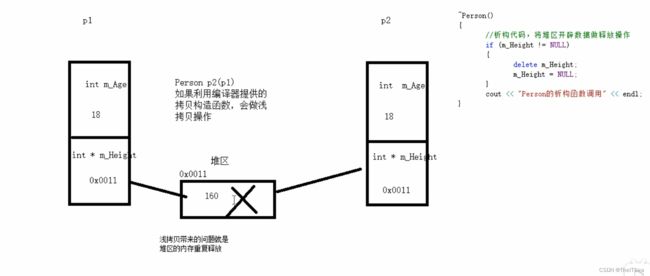
解决默认拷贝构造函数所带来的浅拷贝问题,用深拷贝即可解决,即在堆区重新创建一块内存区域来存即可:

4.2.6 初始化列表
作用:
C++提供了初始化列表语法,用来初始化属性
语法:构造函数():属性1(值1),属性2(值2)... {}
示例:
#include 4.2.7 类对象作为类成员
C++类中的成员可以是另一个类的对象,我们称该成员为 对象成员
例如:
class A {}
class B
{
A a;
}
B类中有对象A作为成员,A为对象成员
那么当创建B对象时,A与B的构造和析构的顺序是谁先谁后?
示例:
#include 4.2.8 静态成员
静态成员就是在成员变量和成员函数前加上关键字static,称为静态成员
静态成员分为:
- 静态成员变量
- 所有对象共享同一份数据
- 在编译阶段分配内存
- 类内声明,类外初始化
- 静态成员函数
- 所有对象共享同一个函数
- 静态成员函数只能访问静态成员变量
示例1:静态成员变量
#include 示例2:静态成员函数
#include 4.3 C++对象模型和this指针
4.3.1 成员变量和成员函数分开存储
在C++中,类内的成员变量和成员函数分开存储
只有非静态成员变量才属于类的对象上
#include 4.3.2 this指针概念
通过4.3.1我们知道在C++中成员变量和成员函数是分开存储的
每一个非静态成员函数只会诞生一份函数实例,也就是说多个同类型的对象会共用一块代码
那么问题是:这一块代码是如何区分那个对象调用自己的呢?
c++通过提供特殊的对象指针,this指针,解决上述问题。this指针指向被调用的成员函数所属的对象
this指针是隐含每一个非静态成员函数内的一种指针
this指针不需要定义,直接使用即可
this指针的用途:
- 当形参和成员变量同名时,可用this指针来区分
- 在类的非静态成员函数中返回对象本身,可使用return *this
#include 4.3.3 空指针访问成员函数
C++中空指针也是可以调用成员函数的,但是也要注意有没有用到this指针
如果用到this指针,需要加以判断保证代码的健壮性
示例:
//空指针访问成员函数
class Person {
public:
void ShowClassName() {
cout << "我是Person类!" << endl;
}
void ShowPerson() {
if (this == NULL) {
return;
}
//如果不通过上面的判断的话,下面的mAge属性是默认的带有this指向的,是一种省略的写法
//完整的样子应该为 cout << this->mAge << endl;
//因为p指针是指向空的,就代表this也是个空指针,所以空指针引用mAge属性必然报错
cout << mAge << endl;
}
public:
int mAge;
};
void test01()
{
Person * p = NULL;
p->ShowClassName(); //空指针,可以调用成员函数
p->ShowPerson(); //但是如果成员函数中用到了this指针,就不可以了
}
int main() {
test01();
system("pause");
return 0;
}
4.3.4 const修饰成员函数
常函数:
- 成员函数后加const后我们称为这个函数为常函数
- 常函数内不可以修改成员属性
- 成员属性声明时加关键字mutable后,在常函数中依然可以修改
常对象:
- 声明对象前加const称该对象为常对象
- 常对象只能调用常函数
示例:
#include 4.4 友元
生活中你的家有客厅(Public),有你的卧室(Private)
客厅所有来的客人都可以进去,但是你的卧室是私有的,也就是说只有你能进去
但是呢,你也可以允许你的好闺蜜好基友进去。
在程序里,有些私有属性 也想让类外特殊的一些函数或者类进行访问,就需要用到友元的技术
友元的目的就是让一个函数或者类 访问另一个类中私有成员
友元的关键字为 friend
友元的三种实现
- 全局函数做友元
- 类做友元
- 成员函数做友元
4.4.1 全局函数做友元
#include 4.4.2 类做友元
class Building;
class goodGay
{
public:
goodGay();
void visit();
private:
Building *building;
};
class Building
{
//告诉编译器 goodGay类是Building类的好朋友,可以访问到Building类中私有内容
friend class goodGay;
public:
Building();
public:
string m_SittingRoom; //客厅
private:
string m_BedRoom;//卧室
};
Building::Building()
{
this->m_SittingRoom = "客厅";
this->m_BedRoom = "卧室";
}
goodGay::goodGay()
{
building = new Building;
}
void goodGay::visit()
{
cout << "好基友正在访问" << building->m_SittingRoom << endl;
cout << "好基友正在访问" << building->m_BedRoom << endl;
}
void test01()
{
goodGay gg;
gg.visit();
}
int main(){
test01();
system("pause");
return 0;
}
4.4.3 成员函数做友元
#include 4.5 运算符重载
运算符重载概念:对已有的运算符重新进行定义,赋予其另一种功能,以适应不同的数据类型
4.5.1 加号运算符重载
作用:实现两个自定义数据类型相加的运算
#include 总结1:对于内置的数据类型的表达式的的运算符是不可能改变的
总结2:不要滥用运算符重载
4.5.2 左移运算符重载
作用:可以输出自定义数据类型
#include 总结:重载左移运算符配合友元可以实现输出自定义数据类型
4.5.3 递增运算符重载
作用: 通过重载递增运算符,实现自己的整型数据
#include 总结: 前置递增返回引用,后置递增返回值
4.5.4 赋值运算符重载
c++编译器至少给一个类添加4个函数
- 默认构造函数(无参,函数体为空)
- 默认析构函数(无参,函数体为空)
- 默认拷贝构造函数,对属性进行值拷贝
- 赋值运算符 operator=, 对属性进行值拷贝
如果类中有属性指向堆区,做赋值操作时也会出现深浅拷贝问题
示例:
#include 4.5.5 关系运算符重载
**作用:**重载关系运算符,可以让两个自定义类型对象进行对比操作
示例:
#include 4.5.6 函数调用运算符重载
- 函数调用运算符 () 也可以重载
- 由于重载后使用的方式非常像函数的调用,因此称为仿函数
- 仿函数没有固定写法,非常灵活
示例:
#include 4.6 继承
继承是面向对象三大特性之一
有些类与类之间存在特殊的关系,例如下图中:
我们发现,定义这些类时,下级别的成员除了拥有上一级的共性,还有自己的特性。
这个时候我们就可以考虑利用继承的技术,减少重复代码
4.6.1 继承的基本语法
例如我们看到很多网站中,都有公共的头部,公共的底部,甚至公共的左侧列表,只有中心内容不同
接下来我们分别利用普通写法和继承的写法来实现网页中的内容,看一下继承存在的意义以及好处
普通实现:
//Java页面
class Java
{
public:
void header()
{
cout << "首页、公开课、登录、注册...(公共头部)" << endl;
}
void footer()
{
cout << "帮助中心、交流合作、站内地图...(公共底部)" << endl;
}
void left()
{
cout << "Java,Python,C++...(公共分类列表)" << endl;
}
void content()
{
cout << "JAVA学科视频" << endl;
}
};
//Python页面
class Python
{
public:
void header()
{
cout << "首页、公开课、登录、注册...(公共头部)" << endl;
}
void footer()
{
cout << "帮助中心、交流合作、站内地图...(公共底部)" << endl;
}
void left()
{
cout << "Java,Python,C++...(公共分类列表)" << endl;
}
void content()
{
cout << "Python学科视频" << endl;
}
};
//C++页面
class CPP
{
public:
void header()
{
cout << "首页、公开课、登录、注册...(公共头部)" << endl;
}
void footer()
{
cout << "帮助中心、交流合作、站内地图...(公共底部)" << endl;
}
void left()
{
cout << "Java,Python,C++...(公共分类列表)" << endl;
}
void content()
{
cout << "C++学科视频" << endl;
}
};
void test01()
{
//Java页面
cout << "Java下载视频页面如下: " << endl;
Java ja;
ja.header();
ja.footer();
ja.left();
ja.content();
cout << "--------------------" << endl;
//Python页面
cout << "Python下载视频页面如下: " << endl;
Python py;
py.header();
py.footer();
py.left();
py.content();
cout << "--------------------" << endl;
//C++页面
cout << "C++下载视频页面如下: " << endl;
CPP cp;
cp.header();
cp.footer();
cp.left();
cp.content();
}
int main() {
test01();
system("pause");
return 0;
}
继承实现:
//公共页面
class BasePage
{
public:
void header()
{
cout << "首页、公开课、登录、注册...(公共头部)" << endl;
}
void footer()
{
cout << "帮助中心、交流合作、站内地图...(公共底部)" << endl;
}
void left()
{
cout << "Java,Python,C++...(公共分类列表)" << endl;
}
};
//Java页面
class Java : public BasePage
{
public:
void content()
{
cout << "JAVA学科视频" << endl;
}
};
//Python页面
class Python : public BasePage
{
public:
void content()
{
cout << "Python学科视频" << endl;
}
};
//C++页面
class CPP : public BasePage
{
public:
void content()
{
cout << "C++学科视频" << endl;
}
};
void test01()
{
//Java页面
cout << "Java下载视频页面如下: " << endl;
Java ja;
ja.header();
ja.footer();
ja.left();
ja.content();
cout << "--------------------" << endl;
//Python页面
cout << "Python下载视频页面如下: " << endl;
Python py;
py.header();
py.footer();
py.left();
py.content();
cout << "--------------------" << endl;
//C++页面
cout << "C++下载视频页面如下: " << endl;
CPP cp;
cp.header();
cp.footer();
cp.left();
cp.content();
}
int main() {
test01();
system("pause");
return 0;
}
总结:
继承的好处:可以减少重复的代码
class A : public B;
A 类称为子类 或 派生类
B 类称为父类 或 基类
派生类中的成员,包含两大部分:
一类是从基类继承过来的,一类是自己增加的成员。
从基类继承过过来的表现其共性,而新增的成员体现了其个性。
4.6.2 继承方式
继承的语法:class 子类 : 继承方式 父类
继承方式一共有三种:
- 公共继承
- 保护继承
- 私有继承
示例:
class Base1
{
public:
int m_A;
protected:
int m_B;
private:
int m_C;
};
//公共继承
class Son1 :public Base1
{
public:
void func()
{
m_A; //可访问 public权限
m_B; //可访问 protected权限
//m_C; //不可访问
}
};
void myClass()
{
Son1 s1;
s1.m_A; //其他类只能访问到公共权限
}
//保护继承
class Base2
{
public:
int m_A;
protected:
int m_B;
private:
int m_C;
};
class Son2:protected Base2
{
public:
void func()
{
m_A; //可访问 protected权限
m_B; //可访问 protected权限
//m_C; //不可访问
}
};
void myClass2()
{
Son2 s;
//s.m_A; //不可访问
}
//私有继承
class Base3
{
public:
int m_A;
protected:
int m_B;
private:
int m_C;
};
class Son3:private Base3
{
public:
void func()
{
m_A; //可访问 private权限
m_B; //可访问 private权限
//m_C; //不可访问
}
};
class GrandSon3 :public Son3
{
public:
void func()
{
//Son3是私有继承,所以继承Son3的属性在GrandSon3中都无法访问到
//m_A;
//m_B;
//m_C;
}
};
4.6.3 继承中的对象模型
问题:从父类继承过来的成员,哪些属于子类对象中?
示例:
class Base
{
public:
int m_A;
protected:
int m_B;
private:
int m_C; //私有成员只是被隐藏了,但是还是会继承下去
};
//公共继承
class Son :public Base
{
public:
int m_D;
};
void test01()
{
//大小为16 四个int类型所以是16个字节
//父类中所有非静态成员属性都会被子类继承下去
//父类中私有成员属性是被编译器给隐藏了,因此是访问不到,但是确实被继承下去了
cout << "sizeof Son = " << sizeof(Son) << endl;
}
int main() {
test01();
system("pause");
return 0;
}
利用工具查看:
打开工具窗口后,定位到当前CPP文件的盘符
然后输入: cl /d1 reportSingleClassLayout查看的类名 所属文件名
效果如下图:
结论: 父类中私有成员也是被子类继承下去了,只是由编译器给隐藏后访问不到
4.6.4 继承中构造和析构顺序
子类继承父类后,当创建子类对象,也会调用父类的构造函数
问题:父类和子类的构造和析构顺序是谁先谁后?
示例:
class Base
{
public:
Base()
{
cout << "Base构造函数!" << endl;
}
~Base()
{
cout << "Base析构函数!" << endl;
}
};
class Son : public Base
{
public:
Son()
{
cout << "Son构造函数!" << endl;
}
~Son()
{
cout << "Son析构函数!" << endl;
}
};
void test01()
{
//继承中 先调用父类构造函数,再调用子类构造函数,析构顺序与构造相反
Son s;
}
int main() {
test01();
system("pause");
return 0;
}
总结:继承中 先调用父类构造函数,再调用子类构造函数,析构顺序与构造相反
4.6.5 继承同名成员处理方式
问题:当子类与父类出现同名的成员,如何通过子类对象,访问到子类或父类中同名的数据呢?
- 访问子类同名成员 直接访问即可
- 访问父类同名成员 需要加作用域
示例:
class Base {
public:
Base()
{
m_A = 100;
}
void func()
{
cout << "Base - func()调用" << endl;
}
void func(int a)
{
cout << "Base - func(int a)调用" << endl;
}
public:
int m_A;
};
class Son : public Base {
public:
Son()
{
m_A = 200;
}
//当子类与父类拥有同名的成员函数,子类会隐藏父类中所有版本的同名成员函数
//如果想访问父类中被隐藏的同名成员函数,需要加父类的作用域
void func()
{
cout << "Son - func()调用" << endl;
}
public:
int m_A;
};
void test01()
{
Son s;
//同名成员属性处理
cout << "Son下的m_A = " << s.m_A << endl;
//如果通过子类对象访问到父类中同名成员,需要加作用域
cout << "Base下的m_A = " << s.Base::m_A << endl;
//同名成员函数处理
s.func();
s.Base::func();
//当子类与父类拥有同名的成员函数,子类会隐藏父类中同名成员函数
//加作用域可以访问到父类中的同名函数
s.Base::func(10);
}
int main() {
test01();
system("pause");
return EXIT_SUCCESS;
}
总结:
- 子类对象可以直接访问到子类中同名成员
- 子类对象加作用域可以访问到父类同名成员
- 当子类与父类拥有同名的成员函数,子类会隐藏父类中同名成员函数,加作用域可以访问到父类中同名函数
4.6.6 继承同名静态成员处理方式
问题:继承中同名的静态成员在子类对象上如何进行访问?
静态成员和非静态成员出现同名,处理方式一致
- 访问子类同名成员 直接访问即可
- 访问父类同名成员 需要加作用域
示例:
#include 总结:同名静态成员处理方式和非静态处理方式一样,只不过有两种访问的方式(通过对象 和 通过类名)
4.6.7 多继承语法
C++允许一个类继承多个类
语法: class 子类 :继承方式 父类1 , 继承方式 父类2...
多继承可能会引发父类中有同名成员出现,需要加作用域区分
C++实际开发中不建议用多继承
示例:
class Base1 {
public:
Base1()
{
m_A = 100;
}
public:
int m_A;
};
class Base2 {
public:
Base2()
{
m_A = 200; //开始是m_B 不会出问题,但是改为mA就会出现不明确
}
public:
int m_A;
};
//语法:class 子类:继承方式 父类1 ,继承方式 父类2
class Son : public Base2, public Base1
{
public:
Son()
{
m_C = 300;
m_D = 400;
}
public:
int m_C;
int m_D;
};
//多继承容易产生成员同名的情况
//通过使用类名作用域可以区分调用哪一个基类的成员
void test01()
{
Son s;
cout << "sizeof Son = " << sizeof(s) << endl;
cout << s.Base1::m_A << endl;
cout << s.Base2::m_A << endl;
}
int main() {
test01();
system("pause");
return 0;
}
总结: 多继承中如果父类中出现了同名情况,子类使用时候要加作用域
4.6.8 菱形继承
菱形继承概念:
两个派生类继承同一个基类
又有某个类同时继承者两个派生类
这种继承被称为菱形继承,或者钻石继承
典型的菱形继承案例:
[外链图片转存失败,源站可能有防盗链机制,建议将图片保存下来直接上传(img-eMzrJFJH-1689923846573)(assets/clip_image002.jpg)]
菱形继承问题:
-
羊继承了动物的数据,驼同样继承了动物的数据,当草泥马使用数据时,就会产生二义性。 -
草泥马继承自动物的数据继承了两份,其实我们应该清楚,这份数据我们只需要一份就可以。
示例:
class Animal
{
public:
int m_Age;
};
//继承前加virtual关键字后,变为虚继承
//此时公共的父类Animal称为虚基类
class Sheep : virtual public Animal {};
class Tuo : virtual public Animal {};
class SheepTuo : public Sheep, public Tuo {};
void test01()
{
SheepTuo st;
st.Sheep::m_Age = 100;
st.Tuo::m_Age = 200;
cout << "st.Sheep::m_Age = " << st.Sheep::m_Age << endl;
cout << "st.Tuo::m_Age = " << st.Tuo::m_Age << endl;
cout << "st.m_Age = " << st.m_Age << endl;
}
int main() {
test01();
system("pause");
return 0;
}
总结:
- 菱形继承带来的主要问题是子类继承两份相同的数据,导致资源浪费以及毫无意义
- 利用虚继承可以解决菱形继承问题
4.7 多态
4.7.1 多态的基本概念
多态是C++面向对象三大特性之一
多态分为两类
- 静态多态: 函数重载 和 运算符重载属于静态多态,复用函数名
- 动态多态: 派生类和虚函数实现运行时多态
静态多态和动态多态区别:
- 静态多态的函数地址早绑定 - 编译阶段确定函数地址
- 动态多态的函数地址晚绑定 - 运行阶段确定函数地址
下面通过案例进行讲解多态
#include 总结:
多态满足条件
- 有继承关系
- 子类重写父类中的虚函数
多态使用条件
- 父类指针或引用指向子类对象
4.7.2 纯虚函数和抽象类
在多态中,通常父类中虚函数的实现是毫无意义的,主要都是调用子类重写的内容
因此可以将虚函数改为纯虚函数
纯虚函数语法:virtual 返回值类型 函数名 (参数列表)= 0 ;
当类中有了纯虚函数,这个类也称为抽象类
抽象类特点:
- 无法实例化对象
- 子类必须重写抽象类中的纯虚函数,否则也属于抽象类
示例:
#include 4.7.3 虚析构和纯虚析构
多态使用时,如果子类中有属性开辟到堆区,那么父类指针在释放时无法调用到子类的析构代码
解决方式:将父类中的析构函数改为虚析构或者纯虚析构
虚析构和纯虚析构共性:
- 可以解决父类指针释放子类对象
- 都需要有具体的函数实现
虚析构和纯虚析构区别:
- 如果是纯虚析构,该类属于抽象类,无法实例化对象
虚析构语法:
virtual ~类名(){}
纯虚析构语法:
virtual ~类名() = 0;
类名::~类名(){}
示例:
#include 总结:
1. 虚析构或纯虚析构就是用来解决通过父类指针释放子类对象
2. 如果子类中没有堆区数据,可以不写为虚析构或纯虚析构
3. 拥有纯虚析构函数的类也属于抽象类
5 文件操作
程序运行时产生的数据都属于临时数据,程序一旦运行结束都会被释放
通过文件可以将数据持久化
C++中对文件操作需要包含头文件 < fstream >
文件类型分为两种:
- 文本文件 - 文件以文本的ASCII码形式存储在计算机中
- 二进制文件 - 文件以文本的二进制形式存储在计算机中,用户一般不能直接读懂它们
操作文件的三大类:
- ofstream:写操作
- ifstream: 读操作
- fstream : 读写操作
5.1文本文件
5.1.1写文件
写文件步骤如下:
-
包含头文件
#include
-
创建流对象
ofstream ofs;
-
打开文件
ofs.open(“文件路径”,打开方式);
-
写数据
ofs << “写入的数据”;
-
关闭文件
ofs.close();
文件打开方式:
| 打开方式 | 解释 |
|---|---|
| ios::in | 为读文件而打开文件 |
| ios::out | 为写文件而打开文件 |
| ios::ate | 初始位置:文件尾 |
| ios::app | 追加方式写文件 |
| ios::trunc | 如果文件存在先删除,再创建 |
| ios::binary | 二进制方式 |
注意: 文件打开方式可以配合使用,利用|操作符
例如:用二进制方式写文件 ios::binary | ios:: out
示例:
#include 总结:
- 文件操作必须包含头文件 fstream
- 读文件可以利用 ofstream ,或者fstream类
- 打开文件时候需要指定操作文件的路径,以及打开方式
- 利用<<可以向文件中写数据
- 操作完毕,要关闭文件
5.1.2读文件
读文件与写文件步骤相似,但是读取方式相对于比较多
读文件步骤如下:
-
包含头文件
#include
-
创建流对象
ifstream ifs;
-
打开文件并判断文件是否打开成功
ifs.open(“文件路径”,打开方式);
-
读数据
四种方式读取
-
关闭文件
ifs.close();
示例:
#include 总结:
- 读文件可以利用 ifstream ,或者fstream类
- 利用is_open函数可以判断文件是否打开成功
- close 关闭文件
5.2 二进制文件
以二进制的方式对文件进行读写操作
打开方式要指定为 ios::binary
5.2.1 写文件
二进制方式写文件主要利用流对象调用成员函数write
函数原型 :ostream& write(const char * buffer,int len);
参数解释:字符指针buffer指向内存中一段存储空间。len是读写的字节数
示例:
#include 总结:
- 文件输出流对象 可以通过write函数,以二进制方式写数据
5.2.2 读文件
二进制方式读文件主要利用流对象调用成员函数read
函数原型:istream& read(char *buffer,int len);
参数解释:字符指针buffer指向内存中一段存储空间。len是读写的字节数
示例:
#include - 文件输入流对象 可以通过read函数,以二进制方式读数据
